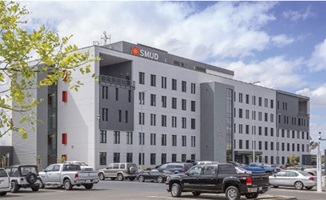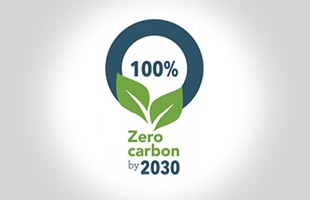Nuestra historia
Estuvimos entregando energía a los clientes de nuestra región desde 1946, pero nuestra historia se remonta mucho más atrás.
En 1923, los ciudadanos votaron para crear SMUD como un servicio eléctrico sin fines de lucro de propiedad comunitaria. Años de estudios de ingeniería, batallas políticas y disputas legales retrasaron nuestra compra del sistema eléctrico local de Pacific Gas & Electric.
En marzo de 1946, la Corte Suprema de California rechazó la petición final de Pacific Gas & Electricpara detener la venta y nueve meses después, finalmente comenzamos a operar. Desde entonces, ayudamos a impulsar el crecimiento explosivo de la región, enfrentamos los desafíos de la crisis energética y nos convertimos en un líder nacional en energía verde y conservación.
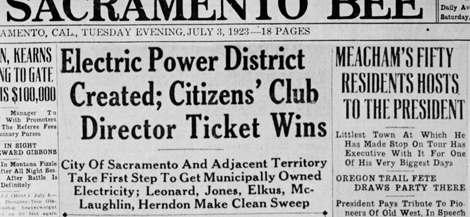
El contrato de venta se firmó en abril. En los siguientes ocho meses, construimos una organización de más de 400 linieros, ingenieros, electricistas, gerentes y oficinistas para hacer cargo de la operación del sistema eléctrico de Sacramento.
Nuestros nuevos empleados se enfrentaron a enormes desafíos. El sistema de distribución eléctrica que tanto tiempo tardó en adquirir era antiguo, algunos de los cuales se remontaban a 1895. Era un revoltijo de sistemas que competían entre sí y que se fusionaron en PG&E.
"Las líneas estaban en pésimas condiciones", dijo el difunto Hugo (Doc) Knapp, quien se retiró en 1977 como asistente del jefe de despacho.
Alrededor de 3000 clientes estaban esperando el servicio eléctrico y agregamos más a la lista de espera cada día. La escasez de linieros calificados en todo el país significó que muchos de nuestros nuevos empleados necesitaban capacitación. Solo unos pocos de los empleados recién contratados tenían experiencia en electricidad. La escasez de automóvil, camiones y cobre empleado en las líneas eléctricas de la posguerra hizo que las cosas fueran aún más difíciles.
Trabajando en habitaciones alquiladas en K Street y en sofocantes chozas de hojalata Quonset en 59th Street, los empleados estuvieron a la altura del desafío. El 31de diciembre de 1946, con poca fanfarria y sin atenuar las luces, comenzamos a suministrar electricidad a Sacramento, cumpliendo con el mandato de los votantes de dos décadas antes.
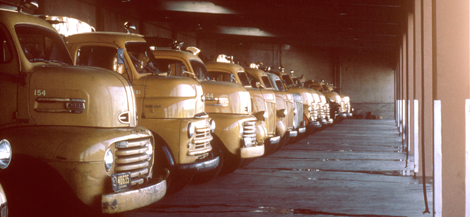
Si bien comenzamos a correr en 1946, el ritmo solo se aceleró en la década de 1950, cuando Sacramento experimentó un estallido de crecimiento.
Durante nuestros primeros 15 años de servicio, el número de clientes creció de 65,000 a 170,000. El consumo eléctrico se triplicó con creces. La Guerra Fría impulsó la expansión de las bases militares de Sacramento, atrayendo a miles de recién llegados a los suburbios recién construidos.
A medida que la economía floreció en la década de 1950y los empleos se volvieron abundantes, la creciente población de Sacramento impulsó la demanda de electricidad. La gente compró cocinas eléctricas, calefacción central, lavadoras, secadoras y lavavajillas eléctricas y una gama de pequeños electrodomésticos: planchas para gofres, cafeteras, cobija eléctricas y calentadores de baño.
En su mayoría, los sacramentanos adoptaron el aire acondicionado. En 1959, las ventas de aires acondicionados de habitación aumentaron un 92 por ciento con respecto a 1958. Por primera vez en la historia, el consumo de electricidad en Sacramento alcanzó su punto máximo en el verano en lugar del invierno.
La granja de la familia Sacramento también cambió significativamente. En lugar de depender de acequias abiertas, los agricultores compraron sistemas estacionales de bombeo y aspersión de riego, lo que los liberó de los caprichos de la naturaleza. Nuestro grupo de Ventas Agrícolas introdujo a los agricultores y ganaderos a los establos lecheros electrificados, la incubación por infrarrojos, la refrigeración y otros ayudantes agrícolas eléctricos.
Incluso en los primeros años, cuando todo, desde camiones hasta cables de cobre y equipos de línea, escaseaban, nuestros empleados diseñaron y construyeron constantemente un sistema flexible y bien integrado. Al final de nuestra primera década completa, nuestro sistema pudo suministrar electricidad en cualquier momento a cualquier hogar o negocio en el área de Sacramento.
Para ayudar a reforzar nuestro suministro de energía, la gerencia negoció un contrato de bajo costo para la energía hidroeléctrica federal del Proyecto del Valle Central. En 1958, para ayudar a que Sacramento fuera "energéticamente independiente", comenzamos la construcción de nuestro propio sistema de plantas de energía hidroeléctrica en la parte superior del río American.
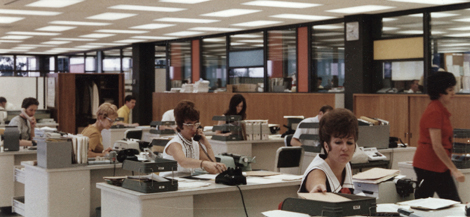
El trabajo duro y las decisiones inteligentes de 1950dieron sus frutos. Para 1961, bajamos nuestras tarifas tres veces y nuestros clientes disfrutaban de algunas de las tarifas más bajas y el servicio más confiable del país.
A mediados de la década1960, la agricultura ya no era el mayor negocio del Valle de Sacramento. Nuevas compañías de la "era espacial", como las de electrónica y defensa, se estaban mudando, cambiando la cara de la ciudad.
El puerto de Sacramento comenzó a manejar buques oceánicos, un importante aeropuerto regional tomó forma en los campos de arroz al oeste de la ciudad, y un huerto de duraznos cerca del río American se transformó en el Sacramento State College. Las subdivisiones de viviendas y los edificios de departamentos surgieron por todas partes a medida que nuestra población de clientes aumentó a 625,000 en 1964.
Nuestro Proyecto del Río Americano Superior comenzó a proporcionar electricidad a las tierras bajas. Mantuvimos el ritmo del continuo crecimiento de la población mediante la expansión de nuestro sistema de distribución de postes y cables. A mediados de los1960, el 95 por ciento del sistema fue reconstruido o recién construido.
Para mejorar el servicio al cliente, desarrollamos un centro integral de consultas y transacciones para clientes. Se construyó un moderno edificio de la sede central en las calles 62y S.
Cuando miraron hacia el futuro a finales de la década de 1960, los afiliadas a nuestra Junta Directiva vieron un crecimiento continuo para la región. Para satisfacer la creciente demanda de energía, aprobaron la construcción de una planta de energía nuclear, que se construiría en 2100 acres en el sudeste del condado de Sacramento.
El sitio recibió el nombre de Rancho Seco.
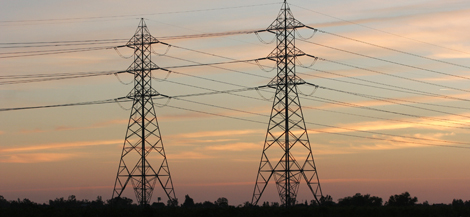
En la década de 1970, los sacramentanos no eran diferentes de la gente de todo el país. Consideraban que la electricidad era un recurso ilimitado y esperaban tener abundantes suministros a su disposición.
Ese punto de vista terminó abruptamente en la década de 1970.
El embargo petrolero árabe desencadenó una aguda crisis energética en Estados Unidos. El gobierno pidió a los estadounidenses que redujeran el consumo de energía en un 10 por ciento. A los propietarios de viviendas y negocios acostumbrados a usar la electricidad libremente se les pidió que cambiaran sus hábitos de la noche a la mañana.
Fue una época de crisis para las compañías eléctricas. Como los servicios públicos de la Costa Oeste estaban conectados por grandes líneas de transmisión, la escasez afectó a 13 estados, incluida California. En el norte de California, una sequía que comenzó en 1976 dejó el fondo de nuestro embalse más grande seco y agrietado. Nuestra producción de energía hidroeléctrica se redujo a la mitad.
Respondimos a las presiones expandiendo las fuentes de generación de energía, y la Junta Directiva aprobó un programa integral de conservación de energía para mostrar a los consumidores cómo usar la energía de manera inteligente.
Este programa ofrecía inspecciones gratis del aislamiento del ático para los propietarios de viviendas y financiamiento a bajo interés para aumentar el aislamiento y los equipos de conservación de energía, como las bombas de calor. Copatrocinamos la primera Energy Expo de Sacramento, una feria de viviendas orientada a la conservación. El esfuerzo de conservación se amplió a las escuelas y grupos comunitarios. Nuestros clientes captaron el espíritu. En 1979, por primera vez, el consumo de electricidad disminuyó durante los periodos más calurosos del verano en Sacramento.
A medida que las compañías generadoras de energía que emplean combustibles fósiles aumentaron sus tarifas 30 al 90 por ciento en respuesta al aumento de los costos del combustible, nosotros también nos vimos obligados a aumentar nuestras tarifas.
Para 1974, Rancho Seco estaba en funcionamiento. Al principio, la planta experimentó retrasos, sobrecostos e interrupciones. Pero para 1977, Rancho Seco parecía estar a la altura de su promesa original. Durante los primeros siete meses del año, produjo más energía que cualquier otra central nuclear del mundo.
En 1979, la industria nuclear se vio sacudida por un accidente en la planta de Three Mile Island en Pensilvania. La Comisión Reguladora Nuclear requirió seguridad y mejoras adicionales que significaron años de trabajo adicional en Rancho Seco. Los aumentos de tarifas se hicieron necesarios para financiar los cambios.
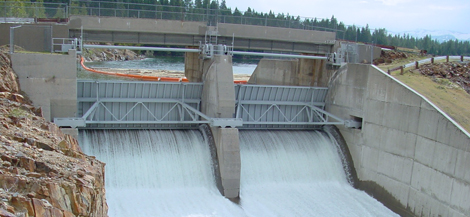
La agitación energética de finales de la década de 1970continuó en la década de 1980. No fue un momento fácil para planear las operaciones futuras de Sacramento.
¿Cuánta electricidad tendríamos que proporcionar y con qué rapidez?
Recurrimos a nuestros clientes propietarios para pedirles sus comentarios. En 1983, basándonos en meses de aportes y análisis públicos, desarrollamos un plan de suministro de energía para la comunidad. Exigía compras de energía a bajo costo de agencias federales, la construcción de una planta de generación de vapor geotérmico en el condado de Sonoma, la ampliación de las instalaciones hidroeléctricas de American River y la generación solar en Rancho Seco.
Los clientes residenciales y comerciales acogieron nuestro llamado a la eficiencia energética. Recurrieron a nosotros en busca de ayuda experta en todo, desde el rediseño de los sistemas de iluminación, calefacción y aire acondicionado hasta la colocación de burletes en las ventanas y la sustitución de las lámparas incandescentes por bombillos fluorescentes compactos (CFL) de bajo consumo.
En respuesta a la preocupación de los clientes sobre el aumento de las tarifas, nuestra Junta estableció un sistema para aliviar el efecto de los cambios en los precios del mercado en los costos de la energía. El personal trabajó para trasladar la base de la independencia energética lejos de Rancho Seco. En lugar de ello, se centraron en comprar, vender e intercambiar poder en todo el oeste de Estados Unidos.
Estas medidas nos ayudaron a mantener las tasas promedio aproximadamente 17 por ciento más bajas que las de las comunidades circundantes. En 1984, los residentes de Folsom votaron a favor de unir a SMUD.
Pero los problemas continuaron plagando Rancho Seco. La planta sufrió una interrupción que duró 27 meses. Realizamos amplias mejoras para mejorar la confiabilidad de la planta, pero el rendimiento continuó siendo decepcionante.
El 6 de junio de 1961, 1989 53,4 por ciento de los votantes pidió el cierre de la planta nuclear, y al día siguiente desconectamos Rancho Seco.
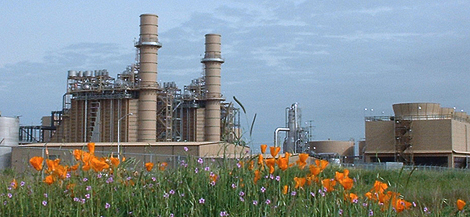
Para reemplazar la energía nuclear, la Junta se alejó del concepto de una gran planta central hacia diversas fuentes de energía, como plantas de cogeneración, energía eólica, energía comprada a bajo costo del noroeste del Pacífico y Canadá, e investigación y desarrollo de tecnologías avanzadas como energía solar, celdas de combustible, turbinas de gas y biomasa.
Intentamos reducir costos en casi todas las áreas. Nuestra plantilla de empleados se redujo a 2000 desde un máximo de casi 2400 , principalmente a través de la deserción. Empleamos la tecnología para mejorar el servicio al cliente sin agregar más empleados, recortamos recursos que no beneficiaban a los clientes e invertimos en inspecciones de campo y mantenimiento preventivo para mejorar aún más la confiabilidad.
A mediados de los años 90 , estábamos en una posición estable. Las principales agencias de calificación de inversiones mejoraron nuestras calificaciones de bonos a A y A-. Nuestras tarifas se mantuvieron estables durante toda la década y nuestras cifras de confiabilidad estuvieron entre las mejores del país. También construimos tres plantas de cogeneración, ampliamos la capacidad de generación en las centrales eléctricas existentes en el Proyecto Upper American River y reforzamos nuestros sistemas de transmisión y distribución.
Reforzamos nuestro enfoque en los clientes, invirtiendo en encuestas y grupos de discusión para comprender mejor sus necesidades y deseos. A los clientes importantes se les asignó un gerente de cuentas, el único punto de contacto para todas sus inquietudes. En 1999, nuestra base de clientes superó los 500.000 y Peak consumo de electricidad alcanzó los 2.759 megavatios por primera vez en la historia.
Pero a medida que la década se acercaba a su fin, los funcionarios estatales propusieron una idea nueva y no probada: la desregulación energética.
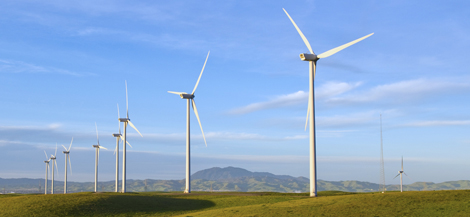
Gracias a meses de planeación y preparación, el temido error Y2K no afectó nuestros sistemas. Pero por si acaso, varios cientos de empleados estuvieron presentes la víspera de Año Nuevo para garantizar que todo funcionara sin problemas.
La verdadera crisis fue una que nadie esperaba: la desregulación ordenada por el estado de la industria de servicios eléctricos y la consiguiente escasez de energía, el aumento de los costos de la energía al por mayor y los cortes rotativos.
Tras la desregulación, el caos del mercado se apoderó de gran parte de Occidente. Los suministros de energía artificialmente ajustados y los sistemas de transmisión congestionados hicieron que los precios de la electricidad se dispararan. En poco tiempo, las compañías de servicios públicos propiedad de inversionistas más grandes de California estaban al borde de la bancarrota y los californianos estaban experimentando sus primeros apagones desde el final de la Segunda Guerra Mundial.
Nos encontramos atados como nunca antes a las dificultades en todo el estado para mantener suministros de electricidad confiables, y en 2000 nos vimos obligados a instituir cortes rotativos durante siete días. Al año siguiente, estábamos estableciendo un sistema para aislarnos de los requisitos de cortar la energía a los clientes en todos los casos, excepto en los casos extremos de inestabilidad de la red en todo el estado.
Los ataques terroristas en Nueva York en 2001 provocaron un aumento de la seguridad en nuestras instalaciones y oficinas. Algunos empleados fueron a la guerra y brindamos ayuda a sus familias.
A mediados de la década, pagamos la última inversión de la planta de Rancho Seco y estábamos desmantelando el equipo de construcción del reactor y la piscina de combustible gastado y comenzamos la construcción de una nueva planta de gas de 500megavatios en la propiedad de Rancho Seco. Reemplazamos el cable subterráneo que se extiende a lo largo de cientos de miles de pies para mejorar aún más la confiabilidad y aplicar una renovación de licencia de 50años en nuestras instalaciones de generación hidroeléctrica de 688MW.
Incluso mientras lidiábamos con la desregulación y otros problemas difíciles, seguimos adelante con importantes esfuerzos de energía verde, como nuestro proyecto de energía eólica en el condado de Solano, All-Electric Smart Homes℠, Greenergy®, vehículos híbridos enchufables y un serial de otras iniciativas.
2013
Reubicamos nuestro patio corporativo de 59th Street en East Sacramento al Centro de Operaciones del Campus Este (EC-OC). Además de brindarles a nuestros equipos de campo más espacio para operar y brindarles un impulso económico a la región, el EC-OC recibió el estatus LEED Platinum del US Green Building Council por sus características de ahorro de energía.
2014
La Comisión Federal Reguladora de Energía extendió nuestra licencia operativa para el Proyecto Upper American River (UARP) por otros 50 años. UARP es una instalación de generación hidroeléctrica que consta de 11 embalses y ocho centrales eléctricas en el vecino condado de El Dorado.
2016
Una importante expansión de nuestro programa SolarShares® y la instalación de paneles solares 109000 en Rancho Seco nos permitieron proporcionar a los propietarios de los Sacramento Kings el 85 por ciento de la energía necesaria para el resplandeciente Golden 1 Center, el estadio deportivo más verde del mundo.
2020
Con la llegada de la pandemia de COVID-19 a fines de febrero, implementamos de inmediato medidas de seguridad que incluyeron el cierre de todos nuestros edificios al público y el traslado de aproximadamente 1,400 empleados al trabajo remoto desde casa.
2021
Para combatir el cambio climático y mejorar la mala calidad del aire de Sacramento, nuestra Junta aprobó por unanimidad una Zero Carbon Plan que nos compromete a eliminar todas las emisiones de carbono de nuestro suministro de energía para 2030. Es el plan de energía limpia más agresivo de cualquier gran compañía de servicios públicos de Estados Unidos.
Estamos en camino de construir una red inteligente que nos ayude a operar de manera más eficiente y le brinde mejores opciones en la forma en que usa la energía.
Esta década promete ser un momento dinámico en la industria eléctrica, y estamos comprometidos a ayudarlo a hacer realidad la promesa de nuevas y emocionantes tecnologías mientras continuamos brindándole un servicio confiable y asequible.




